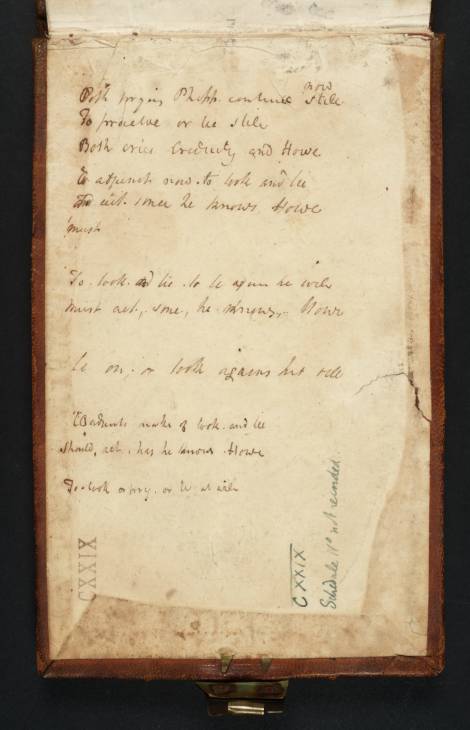Joseph Mallord William Turner Stanzas Referring to Jonathan Wathen Phipps and Baroness Howe (Inscription by Turner) c.1812-13
Inside front cover of sketchbook
Joseph Mallord William Turner,
Stanzas Referring to Jonathan Wathen Phipps and Baroness Howe (Inscription by Turner)
c.1812-13
(Inside front cover of sketchbook)
Joseph Mallord William Turner 1775–1851
Inside Front Cover:
Stanzas Referring to Jonathan Wathen Phipps and Baroness Howe (Inscription by Turner) c.1812–13
D40818
Ink on white wove paper, 110 x 178 mm
Inscribed by Turner in ink with verse (see main catalogue entry)
Inscribed by an unknown hand in pencil ‘CXXIX | Schedule No. not recorded’, bottom left Stamped in brown ‘CXXIX’ top left.
Inscribed by Turner in ink with verse (see main catalogue entry)
Inscribed by an unknown hand in pencil ‘CXXIX | Schedule No. not recorded’, bottom left Stamped in brown ‘CXXIX’ top left.
Accepted by the nation as part of the Turner Bequest 1856
References
1909
A.J. Finberg, A Complete Inventory of the Drawings of the Turner Bequest, London 1909, vol.I, p. 361, CXXIX 1, as ‘Draft of verses about “Phipps” ..., continued over inside of cover’.
1990
Andrew Wilton and Rosalind Mallord Turner, Painting and Poetry: Turner’s ‘Verse Book’ and his Work of 1804–1812, exhibition catalogue, Tate Gallery, London 1990, p.176.
Written from right to left down the page, as if inside the back cover and continued from folio 1 (D09058), opposite, Turner’s inscription reads:
Doth prying Phipps continue ^now still
To practice or lie still
Both cries Credulity and Howe
To practice or lie still
Both cries Credulity and Howe
Co adjunct now to look and lie
And wit since he knows Howe
Must
And wit since he knows Howe
Must
To look and lie to lie again he will
Must act, since, he knows Howe
Must act, since, he knows Howe
Lie on; or look agains[t] his will
Co adjuncts make of look and lie
Should, act, he knows Howe
Should, act, he knows Howe
To look or pry or lie at will1
One can construe enough of these lines to understand them as an attempt at a polemical quip. The principal characters can be identified. ‘Howe’ is Baroness Howe, who had already earned Turner’s poetic disapproval for her demolition of Alexander Pope’s Villa at Twickenham in 1807.2 There is some further allusion to Pope’s grotto on folios 6 verso and 7 of this sketchbook (D09066, D09067). ‘Phipps’ is Jonathan Wathen Phipps (1769–1853),3 oculist to George III, who was knighted in 1814 and assumed the surname Waller when he succeeded to the Baronetcy in 1815. Unfortunately he lost his own sight. Baroness Howe married Phipps on 1 October 1812 at St James’s Church, London and the Duke of Cumberland gave the bride away. Howe was widowed in 1797 having first married the Hon. Penn Asheton Curzon (son and heir of Viscount Curzon) in 1787 and had three sons and one daughter. Phipps’s first wife, Elizabeth Slack, died in 1809 after the couple had produced two sons, including Sir Thomas Wathen Waller, 2nd Bt. born on 24 June 1805 and two daughters. The marriage was evidently a topic of conversation at least in November 1812 for a letter from Lord Sheffield, Sheffield Place, to Frederick North of 7 November 1812 discusses the ‘mesalliance’ (inappropriate marriage of different classes) of Baroness Howe and her oculist Mr Phipps, ‘whose children are to be taken from her and his not allowed to enter the house’.4
The exact nature or context of the lying and ‘practicing’ referred to is not clear from Turner’s poetry, but was serious enough to move the artist to put pen to paper. The form that Turner is essaying is similar to that of a political squib, so it may be that the context is anti-Tory, given some association of this sketchbook with Walter Fawkes who was very active in the radical Whig cause. If so, these verses might well have been composed for amusement and entertainment at Fawkes’s Yorkshire seat, Farnley Hall. For variations or continuations of these lines see folios 1–2 verso (D09058–D09061).
David Hill
October 2008
The transcription here is indebted to, but differs in some respects from that offered by Rosalind Mallord Turner in Wilton and Mallord Turner 1990.
Pope’s Villa stood on the banks of the River Thames at Twickenham. It was demolished by Baroness Howe in 1807 to make way for a new house. This was widely regarded as an act of modern philistinism. The old villa was the subject of a painting by Turner exhibited in 1808 (Martin Butlin and Evelyn Joll, The Painting of J.M.W. Turner, revised ed., New Haven and London 1984, pp.55–6 no.72, pl.82; Sotheby’s sale, London, 9 July 2008 (lot 91), and various contemporary attempts at poetry by the artist; see Wilton and Mallord Turner 1990, p.176.
How to cite
David Hill, ‘Stanzas Referring to Jonathan Wathen Phipps and Baroness Howe (Inscription by Turner) c.1812–13 by Joseph Mallord William Turner’, catalogue entry, October 2008, in David Blayney Brown (ed.), J.M.W. Turner: Sketchbooks, Drawings and Watercolours, Tate Research Publication, September 2014, https://www

